Abdolhossein Zarrinkoob
Abdolhossein Zarrinkoub (Luri/Persian: عبدالحسین زرینکوب, also Romanized as Zarrinkoob, Zarrinkub, Persian pronunciation: [æbdolhoˈsejn zæɾ[ɾ]iːnˈkuːb]) (March 17, 1923 – September 15, 1999) was a scholar of Iranian literature, history of literature, Persian culture and history.
Abdulhussein Zarrinkoub عبدالحسین زرینکوب | |
|---|---|
 Abdolhossein Zarrinkoub | |
| Born | March 17, 1923 |
| Died | September 15, 1999 (aged 76) |
| Nationality | Iranian |
| Known for | scholar of Iranian literature, history of literature, Persian culture and history |
He was born on March 19, 1923, in Borujerd, Iran, received his PhD from Tehran University in 1955 under the supervision of Badiozzaman Forouzanfar, and held faculty positions at universities such as Oxford University, Sorbonne, and Princeton University.[1]
Research works
Some of his works in English are:
- The Arab Conquest of Iran and its aftermath: in Cambridge History of Iran, Vol. 4, London, 1975.
- Persian Sufism in its historical background, Iranian studies III, 1970
- Nizami, a Lifelong Quest for a Utopia, 1977, Rome.
Literary criticism and comparative literature
Zarrinkoob wrote comparative literature and Persian literary criticism in his book "Naqd-e Adabi" (نقد ادبی, "Literary Criticism").
Rumi and Erfan
Zarrinkoub also researched the Persian poet Molana Jalaleddin Balkhi (Rumi) and his works. Zarrinkoub's "Serr-e Ney" (سرّ نی, "Secret of the Reed") and "Bahr dar Koozeh" (بحر در کوزه, "Sea in a Jug") are critical and comparative analysis of Rumi's Masnavi. "Pelleh-Pelleh ta Molaqat-e Khuda" (پلهپله تا ملاقات خدا, "Step by Step until Visiting God") is also a work he carried out on the same line.
Zarrinkoub's research works on Hafez and Persian mysticism resulted in several books: "Az Kuche-ye Rendan" (از کوچهٔ رندان) and "Arzesh-e Miras-e Sufiyeh" (ارزش میراث صوفیه) are a few examples.
History of Persia
Zarrinkoub wrote "Two Centuries of Silence" (دو قرن سکوت)[2] on Islamic history and Ruzegaran (روزگاران) (The Ages) (Iran's history from the beginning to the fall of the Pahlavi dynasty),[3] which covers the 3,000-year history of Iran since the Aryans migrated to the Iranian plateau.
See also
- Persian literature
- Iranology
- Intellectual Movements in Iran
References
- http://theprince.princeton.edu/cgi-bin/princeton?a=d&d=Princetonian19691008-01. 2. 18&cl=search&srpos=20&dliv=none&st=1&e=-------en-Logical-50--1-byTY-on--summer-ILLUSTRATION---1969 A. H. Zarrinkoub, visiting professor from the University of Tehran, will give the first of a series of weekly lectures on Persian Mystical Literature in its Historical Context.
- ʻAbd al-Ḥusayn Zarrīnʹkūb (2000). Dū qarn sukūt: sarguz̲asht-i ḥavādis̲ va awz̤āʻ-i tārīkhī dar dū qarn-i avval-i Islām (Two Centuries of Silence). Tihrān: Sukhan. OCLC 46632917. ISBN 964-5983-33-6.
- ʻAbd al-Ḥusayn Zarrīnʹkūb (2012). Ruzgaran: Tarikh-i Iran az aghaz ta suqut-i saltanat-i Pahlavi (13th ed. 1391 ed.). Tehran, Iran: Elm Pub. ISBN 978-964-6961-11-1.
External links
- Iranian Researcher - Abdolhossein Zarrinkoub
- ʻAbd al-Ḥusayn Zarrīnʹkūb (1379 (2000)). Dū qarn sukūt: sarguz̲asht-i ḥavādis̲ va awz̤āʻ-i tārīkhī dar dū qarn-i avval-i Islām (Two Centuries of Silence). Tihrān: Sukhan. OCLC 46632917, ISBN 964-5983-33-9.